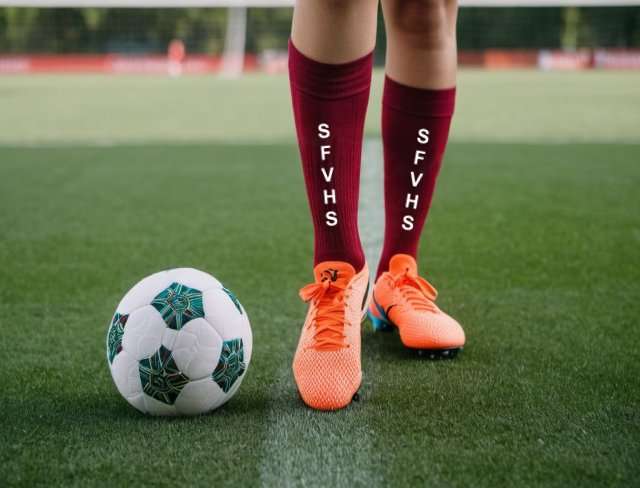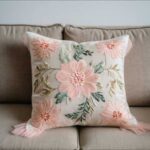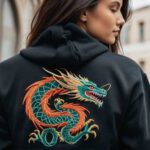Cover Those Feet In Style
A Beginner's Guide To Embroidered Socks
Introduction
Embroidered socks have become a trendy accessory, offering a unique blend of style and personality to your wardrobe. Whether you’re looking to showcase your creativity or add a touch of flair to your outfit, embroidered socks are the perfect choice. In this comprehensive guide, we’ll walk you through everything you need to know to create your own embroidered socks and elevate your style game.
Embroidered socks are more than just a fashion statement; they’re a form of self expression. With endless design possibilities, you can truly make a statement with your socks. Whether you prefer bold and colorful patterns or subtle and intricate designs, embroidered socks allow you to showcase your personality and creativity with every step you take. So why settle for plain, boring socks when you can turn heads and stand out from the crowd with your own custom creations? Let’s dive in and explore the world of embroidered socks together!
Exploring Sock Styles
Embroidered socks offer a myriad of opportunities to express your personal style and elevate your fashion game. Before delving into the specific styles of socks suitable for embroidery, it’s essential to understand the transformative power of this accessory. Embroidery adds texture, color, and dimension to an otherwise ordinary garment, turning a basic necessity into a statement piece. Whether you’re drawn to whimsical designs, intricate patterns, or bold motifs, embroidered socks allow you to infuse your personality into every step you take.
Now, let’s delve into a variety of sock styles and explore how embroidery can enhance their aesthetic appeal.
Ankle Socks: Ankle socks are a versatile option that pairs well with a wide range of footwear, from sneakers to loafers. Their shorter length makes them ideal for casual, everyday wear. Embroidering ankle socks allows you to add a subtle pop of color or a playful motif to your outfit without overwhelming your look.
Crew Socks: Crew socks are slightly longer than ankle socks, typically reaching mid calf. They provide more coverage and warmth, making them suitable for cooler weather or athletic activities. Embroidered crew socks offer an opportunity to showcase larger designs or intricate patterns, making them a statement piece in your wardrobe.
Knee-High Socks: Knee-high socks extend up to the knee or just below it, offering maximum coverage and warmth. They’re perfect for pairing with skirts, dresses, or tall boots to add a touch of elegance and sophistication to your ensemble. Embroidering knee-high socks allows you to create eye catching designs that elongate the legs and draw attention to your footwear.
Thigh-High Socks: Thigh-high socks are the ultimate statement accessory, extending all the way up to the thighs. They’re bold, daring, and guaranteed to make a fashion statement wherever you go. Embroidering thigh-high socks offers endless possibilities for creative expression, whether you opt for intricate lace designs, bold geometric patterns, or whimsical motifs.
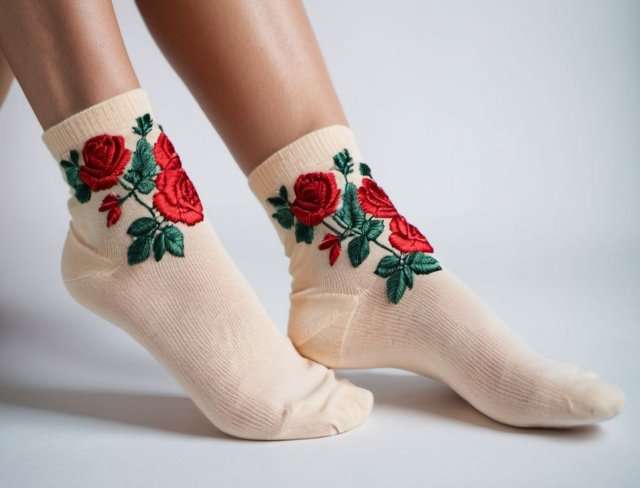
Over-the-Knee Socks: Over-the-knee socks are similar to thigh-high socks but extend slightly higher, often reaching just above the knee. They’re a stylish choice for colder weather or for adding a touch of drama to your outfit. Embroidering over-the-knee socks allows you to create bold and eye catching designs that make a statement.
No-Show Socks: No-show socks, also known as liner socks or invisible socks, are designed to be worn with low cut or no-show footwear such as ballet flats or loafers. They provide minimal coverage while still offering protection and comfort. Embroidering no-show socks allows you to add a touch of personality to your outfit without compromising on comfort or style.
No matter which style of sock you choose, embroidery adds a unique and personalized touch that sets your footwear apart from the rest. Experiment with different styles, colors, and designs to create custom embroidered socks that reflect your individuality and sense of style. Whether you’re dressing up for a special occasion or simply adding a fun twist to your everyday look, embroidered socks are sure to make a lasting impression.
Selecting Sock Materials
Choosing the right material for your socks is essential for comfort, durability, and overall performance. Each material offers unique qualities that cater to different needs and preferences. Let’s explore some common sock materials and their characteristics to help you make the best choice for your embroidered socks.
• Cotton: Cotton is a popular choice for socks due to its breathability and softness. It’s a natural fiber that allows air to circulate, keeping your feet cool and dry throughout the day. Cotton socks are comfortable to wear and gentle on the skin, making them suitable for everyday wear. Additionally, cotton is easy to care for and retains its shape well after washing.
• Wool: Wool socks are known for their warmth and insulation, making them ideal for colder climates or winter activities. Wool fibers have natural insulating properties that trap heat close to the skin, keeping your feet warm even in chilly conditions. Additionally, wool is moisture wicking, meaning it can absorb sweat and keep your feet dry and comfortable. Wool socks are durable and resistant to odors, making them a practical choice for outdoor adventures.
• Synthetic Blends: Synthetic blends, such as polyester or nylon, are often used in athletic socks for their durability and moisture wicking properties. These synthetic fibers are engineered to wick moisture away from the skin, keeping your feet dry and comfortable during intense physical activity. Synthetic socks are lightweight, quick drying, and resistant to shrinking and stretching, making them an excellent choice for sports and outdoor activities.
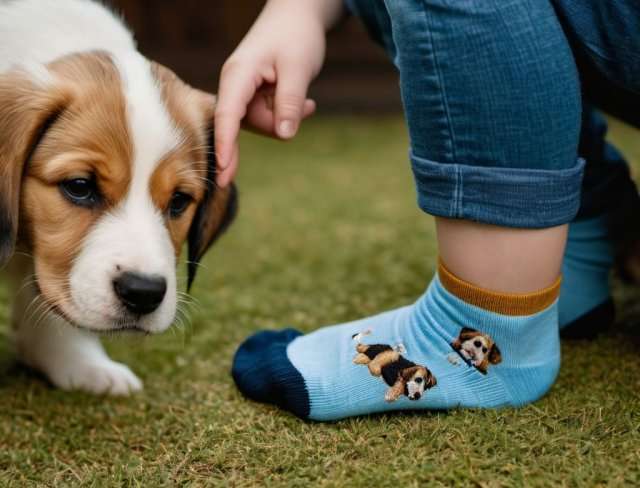
• Bamboo: Bamboo socks are gaining popularity for their softness, breathability, and eco friendly properties. Bamboo fibers are naturally hypoallergenic and antibacterial, making them suitable for sensitive skin. Bamboo socks are breathable and absorbent, keeping your feet cool and dry in warm weather. Additionally, bamboo is a sustainable and renewable resource, making bamboo socks an environmentally friendly choice.
• Silk: Silk socks are luxurious and soft, offering a smooth and comfortable feel against the skin. Silk fibers are naturally lightweight and breathable, making them ideal for dress socks or special occasions. Silk socks provide a sleek and polished look, adding a touch of elegance to any outfit. However, silk socks may require special care and attention when washing to maintain their delicate texture.
When selecting the material for your embroidered socks, consider factors such as the intended use, climate, and personal preference. Choose a material that offers the right balance of comfort, durability, and style to ensure your socks meet your needs and complement your wardrobe. With the right material, your embroidered socks will not only look great but also feel comfortable and perform well throughout the day.
Choosing the Right Thread Type
Selecting the appropriate thread type is crucial for achieving high quality embroidery results that are durable, visually appealing, and complementary to the chosen sock material. Various thread options offer unique characteristics that influence the overall look and feel of the embroidered design. Let’s explore some common thread types and their suitability for different embroidery projects:
• Cotton Thread: Cotton thread is a popular choice for embroidery due to its natural fibers, which provide a soft and matte finish. It’s ideal for intricate designs and delicate stitches, as it tends to blend seamlessly with the fabric, resulting in a smooth and uniform appearance. Cotton thread is highly versatile, making it suitable for a wide range of sock materials, including cotton, wool, and synthetic blends.
• Polyester Thread: Polyester thread is known for its strength, durability, and colorfastness, making it a reliable option for embroidery projects that require long lasting results. It’s resistant to fading, shrinking, and stretching, making it suitable for socks that undergo frequent washing or exposure to harsh conditions. Polyester thread offers a shiny and smooth finish, adding a vibrant and lustrous touch to the embroidered design.
• Rayon Thread: Rayon thread is prized for its silky texture, sheen, and vibrant color palette, making it a popular choice for decorative embroidery projects. It’s lightweight, flexible, and drapes beautifully on the fabric, creating a luxurious and elegant look. Rayon thread is ideal for creating intricate details, bold motifs, and decorative accents on socks, adding a touch of sophistication and glamour to the design.
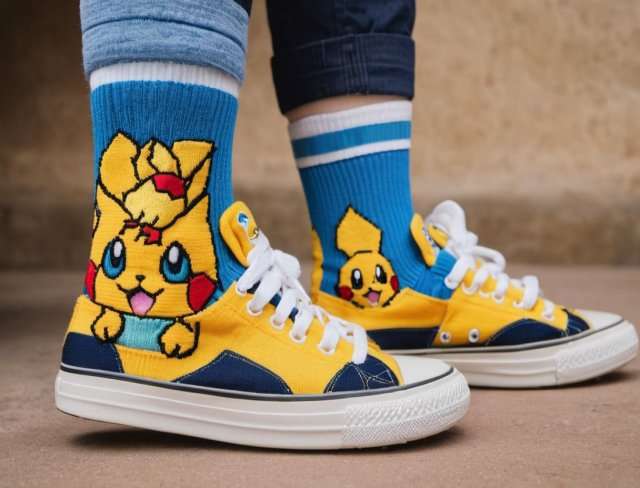
• Metallic Thread: Metallic thread adds a touch of sparkle and glamour to embroidered designs, making it perfect for creating eye catching embellishments and accents on socks. It’s made from metallic fibers, such as polyester or nylon, coated with a metallic foil or film to create a reflective and shiny surface. Metallic thread comes in a variety of colors and finishes, including gold, silver, and metallic hues, allowing you to create dazzling and festive designs that stand out.
• Wool Thread: Wool thread is well suited for embroidery projects that require a textured and rustic look, such as traditional or folk inspired designs. It has a soft and fuzzy texture that adds warmth and dimension to the embroidered design, creating a cozy and tactile feel. Wool thread is commonly used for embroidering socks made from wool or other natural fibers, enhancing the overall look and feel of the finished product.
When choosing the right thread type for your embroidered socks, consider factors such as the desired aesthetic, the type of design, the sock material, and the intended use. Experiment with different thread types, colors, and textures to create unique and personalized designs that reflect your style and creativity. With the right thread choice, your embroidered socks will not only look visually stunning but also withstand the test of time and wear.
Selecting a Color Palette
Choosing the perfect color palette for your embroidered socks is a creative process that can greatly enhance the overall impact and visual appeal of your design. The color scheme you select will set the tone, mood, and style of your socks, allowing you to create personalized and eye catching designs that reflect your individuality and sense of style.
When selecting a color palette for your embroidered socks, consider the following factors:
1. Sock Material and Background Color: Start by considering the color of the sock material itself. Whether you’re working with white cotton socks, black wool socks, or a colorful synthetic blend, the base color of the sock will influence the overall appearance of the embroidery. Choose thread colors that complement or contrast with the sock material to ensure your design stands out and harmonizes with the background.
2. Thread Colors and Variations: Experiment with a variety of thread colors and variations to create depth, dimension, and visual interest in your design. Consider using complementary colors to create harmony and balance, or contrasting colors to make certain elements pop and stand out. Additionally, explore different shades, tones, and gradients within the same color family to add complexity and richness to your embroidered socks.
3. Design Elements and Motifs: Take inspiration from your chosen design elements and motifs when selecting your color palette. Consider the theme, subject matter, and mood of your design, and choose colors that evoke the desired emotions and aesthetics. For example, vibrant hues such as red, orange, and yellow may convey energy and excitement, while soft pastels such as pink, lavender, and mint green may evoke a sense of calm and tranquility.
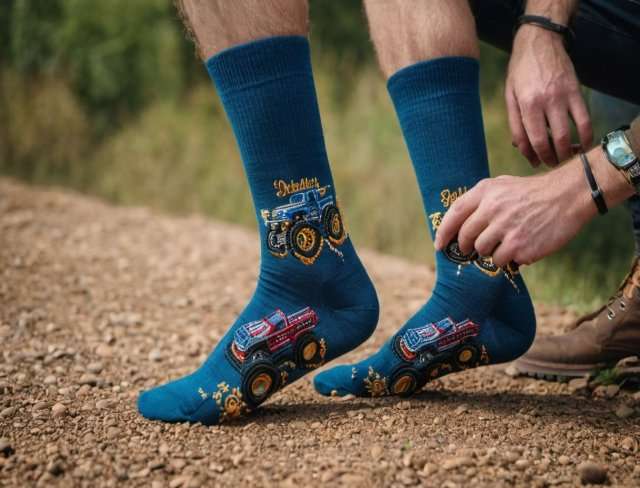
4. Personal Style and Preferences: Ultimately, the color palette you choose should reflect your personal style, preferences, and personality. Consider your favorite colors, patterns, and aesthetics, and incorporate them into your design to create a truly unique and meaningful pair of embroidered socks. Whether you prefer bold and vibrant hues, soft and subtle shades, or a mix of contrasting colors, trust your instincts and let your creativity guide you in selecting the perfect color palette for your socks.
By carefully selecting and coordinating your color palette, you can create embroidered socks that are not only visually stunning but also cohesive, harmonious, and reflective of your individual style and creativity. Don’t be afraid to experiment with different colors, combinations, and techniques to achieve the desired effect. With the right color palette, your embroidered socks will become wearable works of art that add personality, charm, and flair to your wardrobe.
Crafting Your Embroidered Socks
Machine embroidering socks allows you to create intricate and detailed designs with precision and efficiency. Follow these step-by-step instructions to craft your own embroidered socks using a standard embroidery machine:
1. Select Your Design: Start by choosing a design or motif for your embroidered socks. You can use premade embroidery patterns or create your own custom design using embroidery software. Consider the size, complexity, and placement of the design to ensure it fits comfortably on the socks and complements their style.
2. Hoop Your Socks: Place your sock on a flat surface and smooth out any wrinkles or folds. Use a specialized sock hoop or a smaller embroidery hoop to secure the sock in place, ensuring it’s taut and flat within the hoop. Position the hoop so that the area you want to embroider is centered and aligned with the machine’s needle.
3. Thread Your Machine: Select thread colors that complement your design and match the color palette of your socks. Wind the chosen threads onto the machine’s bobbin and spool, ensuring they’re properly threaded and tensioned according to the machine’s instructions. Adjust the machine settings, such as stitch length and tension, to achieve the desired results.
4. Test the Design: Before embroidering the socks, it’s essential to test the design on a scrap piece of fabric to ensure it stitches out correctly. Use a similar fabric and stabilizer as your socks and run a test stitch to check for any issues, such as thread tension, needle breaks, or design alignment. Make any necessary adjustments to the machine settings or design before proceeding.
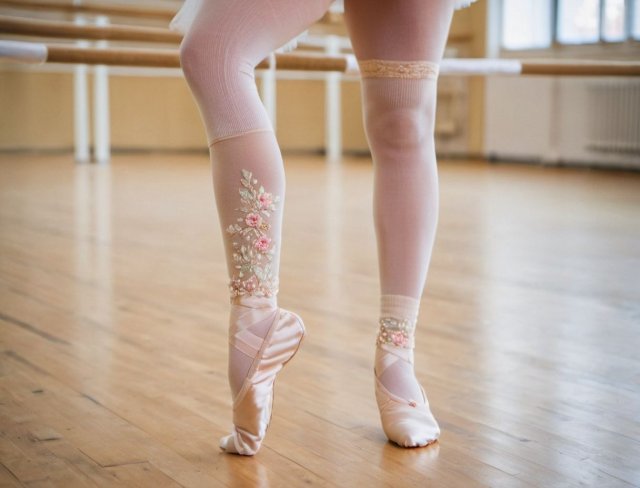
5. Embroider the Design: Once you’re satisfied with the test stitch, it’s time to embroider the design onto your socks. Place the hooped socks onto the embroidery machine’s bed, ensuring they’re securely held in place. Start the machine and monitor the stitching process, adjusting the speed or tension as needed to achieve optimal results. Allow the machine to complete the embroidery, stitching out each color and detail of the design with precision and accuracy.
6. Remove the Hoop: Once the embroidery is complete, carefully remove the hoop from the machine and unhoop the socks. Gently trim any excess thread tails or jump stitches using embroidery scissors, being careful not to cut into the fabric. Inspect the embroidered design for any imperfections or loose stitches, making any necessary repairs or adjustments as needed.
7. Finish and Press: Once you’ve completed the embroidery, take a moment to inspect your socks for any loose threads or uneven stitching. Trim any excess thread with scissors, being careful not to cut into the fabric. Gently stretch the fabric to ensure the embroidery lays flat against the sock surface. Remove any stabilizer from the back of the embroidery and press the socks with a steam iron to set the stitches and smooth out any wrinkles. Allow the socks to cool completely before wearing or packaging them.
By following these step-by-step instructions, you can create beautifully embroidered socks using a standard embroidery machine. Experiment with different designs, thread colors, and techniques to personalize your socks and showcase your creativity and style. Whether you’re embroidering socks for yourself or another reason, machine embroidery offers endless possibilities for customizing and embellishing this everyday accessory.
Troubleshooting Common Issues
1. Thread Breaks: Thread breaks can occur for various reasons, such as incorrect tension, dull needles, or thread jams. To troubleshoot thread breaks, first, check the tension settings on your embroidery machine. Adjust the tension as needed to ensure it’s neither too tight nor too loose. Next, inspect the needle for any signs of damage or dullness and replace it if necessary. Finally, check for any thread jams or obstructions in the machine’s thread path and clear them to prevent further breaks.
2. Tension Problems: Uneven or inconsistent tension can result in puckering, looping, or skipped stitches in your embroidery. To troubleshoot tension problems, start by adjusting the tension settings on your embroidery machine. Gradually increase or decrease the tension until you achieve a balanced and even stitch quality. Additionally, ensure that the bobbin tension is correctly adjusted and that the bobbin is wound smoothly and evenly.
3. Misalignment: Misalignment can occur when the design shifts or drifts during the embroidery process, resulting in uneven or crooked stitching. To troubleshoot misalignment issues, ensure that the fabric is properly hooped and stabilized to prevent shifting during embroidery. Check the design placement on your embroidery software or machine to ensure it’s centered and aligned correctly. If misalignment persists, consider rehooping the fabric or adjusting the design placement before restarting the embroidery.
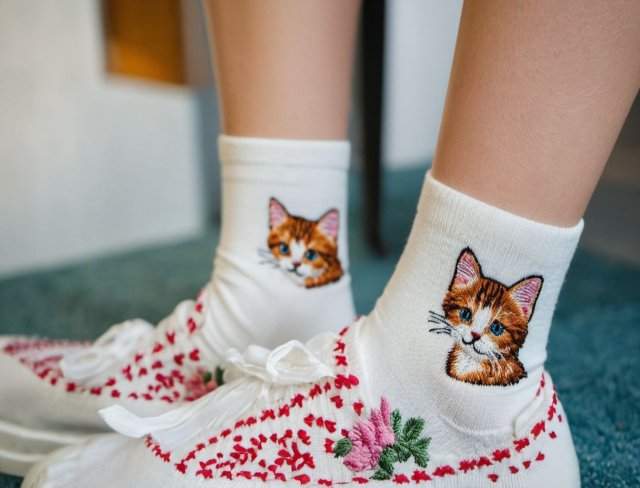
4. Thread Snags or Tangles: Thread snags or tangles can occur when the thread gets caught on rough edges or sharp corners during embroidery. To troubleshoot thread snags, inspect the fabric and embroidery area for any rough patches or obstructions. Smooth out any rough edges or trim away any excess fabric that may be causing the thread to snag. Additionally, check the tension and thread path on your embroidery machine to ensure smooth and uninterrupted stitching.
5. Needle Breakage: Needle breakage can occur if the needle encounters resistance or hits a hard object during embroidery. To troubleshoot needle breakage, check the needle for any signs of damage, such as bends or burrs, and replace it if necessary. Ensure that the needle is securely inserted and tightened in the needle clamp and that it’s the correct size and type for the fabric and thread being used. Finally, adjust the needle penetration depth or speed settings on your embroidery machine to reduce the risk of needle breakage.
6. Design Distortion: Design distortion can occur when the fabric is not properly hooped or stabilized, resulting in puckering, stretching, or warping of the embroidery. To troubleshoot design distortion, ensure that the fabric is hooped securely and evenly without any wrinkles or folds. Use appropriate stabilizer materials and techniques to support the fabric during embroidery, taking into account factors such as fabric type, design complexity, and thread density.
7. Fabric Puckering: Fabric puckering can occur when the tension is too tight or when the fabric is not properly stabilized during embroidery. To troubleshoot fabric puckering, first, adjust the tension settings on your embroidery machine to reduce tension on the fabric. Additionally, ensure that the fabric is properly hooped and stabilized with the appropriate type and weight of stabilizer. If puckering persists, consider using a larger hoop size or reducing the density of the embroidery design to minimize tension on the fabric.
8. Thread Tension Variations: Variations in thread tension can result in uneven or inconsistent stitching quality throughout the embroidery design. To troubleshoot thread tension variations, check the tension settings on your embroidery machine and adjust them as needed to achieve uniform tension across the entire design. Ensure that the bobbin tension is correctly adjusted and that the bobbin is wound smoothly and evenly.
9. Thread Trimming Errors: Errors in thread trimming can result in uneven or frayed edges around the embroidered design. To troubleshoot thread trimming errors, ensure that the thread trimmer mechanism on your embroidery machine is properly calibrated and functioning correctly. Check for any obstructions or debris that may be interfering with the thread trimming process and clear them if necessary. Additionally, consider manually trimming any excess threads with embroidery scissors after the embroidery is complete to ensure clean and precise edges.
10. Design Registration Issues: Design registration issues can occur when the embroidery design does not align correctly with the fabric or previous stitching. To troubleshoot design registration issues, verify that the design placement is accurate and aligned correctly with the fabric before starting the embroidery. Check for any inconsistencies or distortions in the design file that may be affecting registration and correct them if necessary. Additionally, ensure that the fabric is hooped securely and evenly to prevent shifting or misalignment during embroidery.
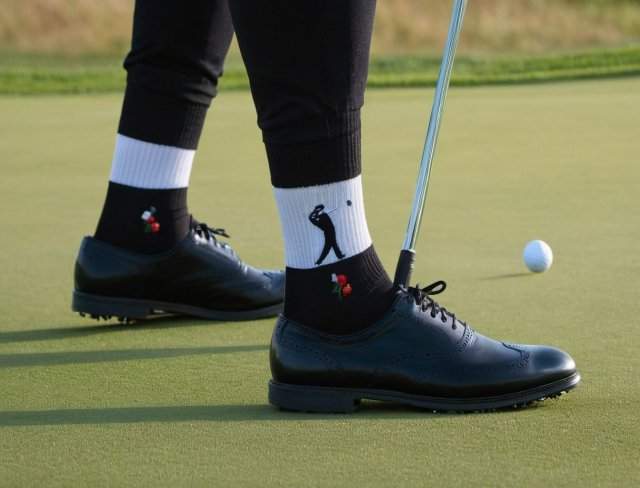
11. Machine Malfunctions: Machine malfunctions such as error messages, jammed needles, or motor issues can disrupt the embroidery process and affect the quality of the finished design. To troubleshoot machine malfunctions, refer to your embroidery machine’s manual for specific error codes and troubleshooting instructions. Follow the recommended steps to resolve the issue, such as clearing any thread jams, restarting the machine, or contacting technical support for assistance. Regular maintenance and cleaning of your embroidery machine can help prevent malfunctions and ensure smooth operation during embroidery.
By addressing these common issues and implementing the corresponding troubleshooting techniques, you can effectively overcome challenges and achieve professional results in your embroidered sock projects. Remember to remain patient, thorough, and attentive to detail throughout the troubleshooting process to ensure the best possible outcome.
Conclusion
The process of creating embroidered socks is a delightful blend of creativity and craftsmanship, offering endless opportunities to express your unique style and personality. From selecting the perfect design to troubleshooting common issues during the embroidery process, crafting embroidered socks is a rewarding endeavor that allows you to showcase your skills and create personalized pieces of wearable art.
Mastering the art and creation of embroidered socks requires patience, practice, and a keen eye for detail. By following the tips, techniques, and troubleshooting strategies outlined in this guide, you can overcome challenges and achieve professional results in your embroidered sock projects. Whether you’re embellishing socks for yourself or creating thoughtful gifts for loved ones, the satisfaction of seeing your designs come to life on this everyday accessory is truly unparalleled.
So, gather your materials, unleash your creativity, and embark on a journey of stitching, sewing, and stitching again. With each pair of embroidered socks you create, you’ll not only add a touch of charm and whimsy to your wardrobe but also leave a lasting impression with every step you take.
Now that you have read through this article, feel free to SHOP for products we have created. If you are looking for something special which isn’t in our store, feel free to contact us.

